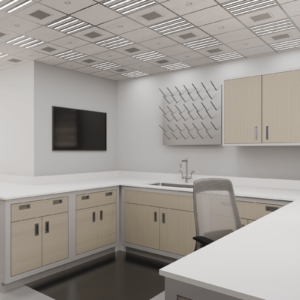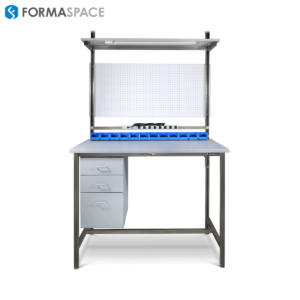Now that an increasing number of professionals at companies such as Apple, Amazon, Glassdoor, and Dell are working remotely from home or other unconventional locations, we wanted to know: will the remote work trend continue to grow in the future or has it already reached a plateau?

To find out more, we spoke with Jim Palmitier, President of MyResourceLibrary (or MRL for short), the ground-breaking virtual library for the contract furniture industry. We reached out to Jim because we had heard they were heavily invested in employees who work remotely, including Jim himself.

But first, we should take a moment to introduce MRL, whose company mission is to “facilitate efficiency in the contract market.” MRL provides tools for professionals working in the contract furniture market for streamlining the front-end ordering process, from design inspiration to providing a quote – and everything in-between. MRL’s Virtual Library platform allows users to find up-to-date information from all the major furniture makers, including Formaspace Office. Users can search MRL to find specific brands or find products in a specific category, such as office desks. They can also browse MRL’s “Fresh Ideas gallery” for settings-based inspiration. Users can then save their collections into custom “Project Binders,” which can be shared privately with their customers and partners.
With that introduction out of the way, it’s time to ask Jim Palmitier our first question.
Remote Work is an Ideal Strategy for Startup Companies
We had heard through the industry grapevine that some of MRL’s employees worked at remote locations, but we didn’t know any of the details. We wanted Jim to give us some specifics on MRL’s hiring practices and the company’s attitude toward remote work.
The answers surprised us.
According to Jim, while MRL maintains its official corporate office in Gilbert, Arizona (just outside of Phoenix), a full 60% of MRL’s employees work remotely, a figure that’s much higher than we expected. (Counted among MRL’s virtual employees is Jim himself, as we’ll discuss shortly.)
We wanted to know, “Why did MRL create a staffing structure with such a high percentage of employees who work remotely?”
Jim explained that one of the reasons that MRL has embraced remote working is that it’s enabled them to access talent from across the country. “We focus more on the individual and the skill set they can bring to us – and their match to our culture – more than we consider their location.”
Another consideration is the virtual nature of their product, which falls squarely in the Software as a Service (SaaS) category. Jim notes that while the company is heavily engaged with furniture and interior design products, MRL itself doesn’t carry physical inventory. Instead, MRL’s Virtual Library and all the supporting data resides in the cloud, where it can be accessed from anywhere, including by the company ’s programmers, as well as its production, sales, and customer service personnel. In other words, as a virtual company, MRL can have ‘virtual’ off-site employees as well.
Are there other advantages?
Cost is another consideration, says Jim. To date, MRL only has 24 employees, making it a small (but growing!) startup company. Allowing a large number of employees to work remotely helps MRL keep a smaller footprint at their “bricks and mortar” headquarters, which in turn, helps reduce MRL’s overhead costs significantly.
Working Remotely Can Help you Get Closer to the Customer
As we mentioned earlier, Jim Palmitier himself is one of MRL’s remote employees – an arrangement that some might find unusual, given that Jim is also president of the company.
We wanted to know if there were any advantages (or disadvantages) about working remotely that he could share with us.
Jim was quick to respond. Remote employees can help smaller companies provide better customer service, especially if they are located close to your key accounts.
“I grew up in West Michigan where, over the last 25 years, I’ve had a variety of positions that were either in the contract furniture industry or directly supported it. Prior to coming to MRL, I spent twelve years leading sales for a furniture dealership; then I was the VP of sales for a small manufacturer based in West Michigan. So I really have touched the contract industry in one way, shape, or form since graduating from college. In fact, my first job out of college was with our family-owned printing company, and I was doing type sets for price books for La-Z-Boy and Steelcase.”
“So I’ve seen the industry as a supplier, I’ve seen it as a furniture dealer, and I’ve seen it as a manufacturer. One of the values that I bring to the company is the fact that I’m based in West Michigan. I am no more than a 45-minute drive from any of the major manufacturers. If you think about Steelcase, Hayworth, Herman Miller, Knoll — they are all here in West Michigan.”
“By having members of our team spread out geographically, it provides us an easier opportunity to reach our customers. And we’re available from the time the Eastern Time zone gets to work to the time the Western zone goes home.”
The Need to Create a Collaborative Culture between Remote Employees
The former CEO of Yahoo Marissa Meyer once said: “people are more productive when they’re alone, but they’re more collaborative and innovative when they’re together.”
We wanted Jim to react to this and get his opinion on the state of collaborative culture at MRL.
“Speaking from personal experience, I definitely agree with that statement,” says Jim. Of course, each individual is different, he goes on to say. “It really depends upon the employee and how they function best. For example, I’m more of a structured, systematic type of thinker, almost more like an accounting or a finance person. I do better at receiving information, considering it, thinking about it, and then discussing it. Yet there are other types of people, especially the younger employees, that thrive in a more purely collaborative environment.”
Managing and coordinating interactions between remote workers in different time zones is actually a much bigger issue than managing different personalities, according to Jim. ”When I joined MRL, one of the first things I started working on was how to solve the problem of interacting with one another without taking a lot of time out of each person’s workday. It’s not like you can walk down the hall and ask them a quick question.”
In response, MRL uses a variety of tools, from text messages and phone calls to collaboration-oriented software, such as OneNote, Microsoft Office 365, and Planner.
“Sometimes there is an advantage for everyone to be in the same spot, virtually speaking. If there is a large project or big enough issue that we’re trying to resolve, quite often, we’ll jump on a Join.me conference call with a handful of our employees and start reviewing something with everyone looking at it together. And when we want to make sure that people are engaged during a meeting, we’ll use Skype video conferencing so that everyone’s visible.”
Setting Boundaries for Yourself When Working Remotely
At this point, we realized that Jim Palmatier has only given us positive answers. We wanted to know about the disadvantages of allowing employees to work remotely from home.
“Speaking for myself,” Jim responded, “one of the concerns that I have is knowing when to stop working. All too often, we have the tendency to push through to get something done, when you should set time aside for yourself as well, to each lunch, for example. When I first started working at MRL, I wouldn’t step away from my desk until 8 o’clock at night, and that’s not healthy. Yes, it’s good to work hard and get stuff done but, you also need to make sure that you’re fresh and ready for the next day.”
“I know everyone says this, but it’s really true: we need to establish a proper work/life balance for our remote employees. In response, we’ve put together a policy for remote workers that includes recommendations on how to set up your home-based work environment and how to keep it separate from your home life.” It also includes specific recommendations, such as starting each day as if you were going into the office, taking lunch at proper mealtimes, and making time to “close yourself off” from distractions when you need to concentrate on work projects.
That’s good advice. We have something to add to Jim’s comments: remote workers also need to consider the health benefits of using safe, ergonomic furniture in the home office. Formaspace Office has a full line of sit-to-stand desks that not only offer convenience (at the touch of a button, the entire desk worksurface moves up and down as a unit) but also important health benefits that come from changing from a seated to standing position throughout the day.

Establishing a Culture of Trust between Management and Remote Workers
While MRL has embraced the concept of employees working remotely, many other employers have not. We wanted to know why that is. Do other companies fear that remote workers won’t put in a full day’s work?
In response, Jim notes that “When people ask me ‘well, how do you know they’re getting their work done when working from home?’ my response is that every one of our team members has a job to do. You need to allow your employees the ability to grow, and sometimes that means you need to just let go of the vine and trust the fact that they’re going to get their job done.”
“As leaders, we do not micro-manage our team, we’re here to guide them and find ways to help them grow. We really don’t focus on the working from home aspect. Instead, we ask ourselves, are we leading and guiding our employees properly? Are we clear about our expectations? Is there a training deficiency affecting this employee? We ask a whole series of questions before immediately jumping to the conclusion that the reason an employee is struggling is due to working remotely.”
“Society and the culture today is so much different than 20 years ago. We’re not clock punchers anymore. For people who have a strong work ethic, work doesn’t have to be a 9 to 5 scenario for them to be successful. Everyone’s unique, and each of us can work in our own way, but it’s about getting the job done. You have to have a passion to be successful.”
On the other hand, Jim notes that not everyone is suited to working remotely. “When we’re talking to the individual job candidates, we do stress that working from home isn’t for everybody. I would consider the opportunity to work remotely to be a great employee benefit, a perk if they can be disciplined enough.”
The Spillover Effect that Remote Work is having on Corporate Office Design
As we saw at NeoCon 2018, the mashup of residential design influences and commercial office furniture design, collectively known as the “resimertial,” continues apace. We want to ask Jim what he thought about the current “resimertial” design trend as well as any other furniture design trends he’s spotted.
“If you look this resimercial trend, as they’re calling it, it looks to me like they are they’re trying to recreate the remote worker’s environment inside an office,” Jim notes. “They’re trying to build office environments that are more comfortable, just like home.”
That’s an excellent point. The resimertial trend could indeed have originated with remote workers.
Jim also sees a generational shift at work as well, which he feels may be quite significant in the long term. “If you look at our industry, at the independent representation, and you look at the dealer principals across the country, they’re a very senior group. There is a gap between that senior level individual in our industry and the much younger Millennials,” says Jim. He predicts the changes from this generational shift will ultimately be much more impactful than whether an individual company employs remote workers or not. The Millennials and Gen Z workers want to make their mark – by pushing for major design changes in the office environment, such as introducing campus-style, open offices.
Predictions for the Future: Will the Remote Work Trend Grow until it Becomes the Default Way of Working?
In closing, we had one final question to ask Jim: What’s the future of remote working? Is it a trend that will reach a certain penetration among employers and stop growing, or will most of us work remotely at some point in the future?
Jim Palmitier doesn’t think will happen any time soon, for a couple of reasons.
First, he doesn’t foresee a “one-size-fits-all” employment model that favors one way of working over the other. “I think the remote worker is more of a cultural thing for each individual company. For some organizations, working remotely is going to be a leading principle in their company’s work culture while, for other companies, it won’t be.”
Second, Jim notes that, at most companies, there may be an upper limit on how many jobs can be performed working remotely. “When you think about the remote worker and you look at the job titles the remote workers hold, many of them are more of your customer-facing individuals, more so than what I would call the internal type employees, such as production or support staff. We’re a little bit unique at MRL because our production staff is remote, which is possible because we have a virtual, cloud-based product. Not every company is the same.”
On that basis, Jim Palmitier doesn’t think that remote working will become a near-universal standard, at least not in the near future. If it were, we’d see major structural changes in the office furniture market due to the shift toward home offices. We haven’t seen that happen yet. Jim agrees: “I don’t think that the trend of remote employment will have an immediate negative impact on the industry.”
But in closing, we can make our own prediction: we think we’ll continue to see growth in resimertial-style furniture, as corporate offices continue to emulate the comforts of working from home.
We’d like to thank Jim Palmitier of MyResourceLibrary for the generous amount of time he spent with us, and we hope the conversation with Formaspace Office has been useful.
At Formaspace Office, If You Can Imagine It, We Can Build It.
Formaspace Office doesn’t just manufacture furniture for employees working in your corporate office, we can also create custom furniture designed for your employees working remotely at home.
So remember, whether you’re at the office or working from home, Formaspace Office has the right solution for you.
Check out our line of executive office furniture for inspiration.
Or try our free Virtual Furniture Design, an interactive 3D design tool that allows you to build photorealistic 3D models of your Formaspace Office furniture online.
If you can imagine it, we can build it.
We offer a full line of standard, customized, and one-of-a-kind, fully bespoke office furniture – all made in America at our Austin, Texas factory headquarters.
That’s why customers, such as Apple, Busch, Capital One, Google, Parabola, Twitter, and Yeti choose Formaspace Office.
Why not contact one of our friendly Formaspace Office Design Consultants today for a free consultation. They can help you find the right custom solution to make your office work more efficient and enjoyable, whether you are in the office or working remotely from home!









